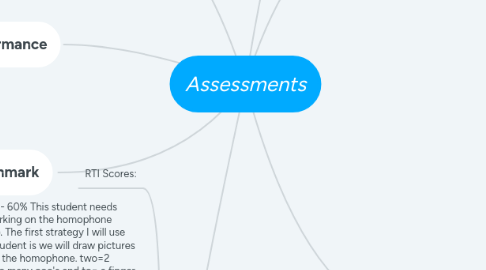Assessments
da Erika Fought


1. Summative
1.1. High stake test, are used to evaluate student learning at the end of an instructional unit by comparing it again some standard or benchmark.
1.1.1. Example: Unit test, STARR test, Benchmark
2. Diagnostic
2.1. Provides information about what the student has already learned and acts as an aid to help teachers plan future lessons.
2.1.1. Example: Pre-test, bell ringers
3. Performance
3.1. A form of testing that requires students to preform a task rather than select an answer from a already made list.
3.1.1. Example: portfolio, short answer questions
4. Intermin Benchmark
4.1. Provides evidence of progress towards standards several times during the year.
4.1.1. Example: six week assessment
5. Formative
5.1. A method teachers use to conduct in-process evaluations of student comprehension, learning needs, and academic progress during a lesson, unit or course.
5.1.1. Example: exit ticket
6. Assessment Data
6.1. RTI Scores:
6.2. 1. student 1- 60% This student needs help on working on the homophone to/too/two. The first strategy I will use with this student is we will draw pictures for each of the homophone. two=2 too=tooooo many ooo's and to= a finger point. The next strategy I will use with this student is they will write a sentence using each of the to/too/two's after they complete this I will have them orally tell me sentences to check for comprehension.
6.3. 2. student 2-50% This student needs assistance on dialogue. The student is struggling with understanding that the punctuation goes INSIDE the quotation marks and where to put the quotation marks. The first strategy I will use with this student is a dialogue mini lesson. For the mini lesson I will have two pairs of shoes the student needs to come up with a conversation the two shoes will have with each other. I will make sure that the student understands that when your talking you don't say said the teacher, said my friend, mumbled my mother. To do so I will say sentences to the student like: "I wish I had a brownie for snack said Ms. Fought." Then I will ask the student why the sentence sounded funny. The second strategy I will use with this student is punctuation. I will work with the student to make sure that he knows the speaker always needs to be separated from the dialogue. To do so we will learn about dialogue tags, here the student will underline the dialogue tag, this helps the student know who the speaker is and separate it from the dialogue, here we will add a comma to separate it.
6.4. 3. student 3- 70% This student is struggling with the homophone their, they're and there. The first strategy I will use with this student is we will draw pictures for each their/there/they're. For their we can turn the i into a person to show ownership. For there we can turn the r into an arrow to show location. For they're we can change the ' to an a to show they are. After the student has draw their pictures we will put it on a book mark that they can keep in their writing folder. The next strategy I will use is a lead4ward strategy I will use the vocabulary pyramid game. The student will work with a partner using the correct they're/there/their in sentences to get to the top of the pyramid. Whoever gets to the top of the pyramid first wins!
7. Hot Questions:
7.1. opening:
7.1.1. guiding:
7.1.1.1. Based on these two sentence what do you notice?
7.1.1.2. Compare the different punctuation used.
7.1.1.3. Demonstrate how to use dialogue in a sentence?
7.1.1.4. What evidence can you present for homophones?
7.1.1.5. closing:
7.1.1.5.1. Create a sentence using the appropriate their/there/they're
7.1.1.5.2. Generate a sentence using dialogue

